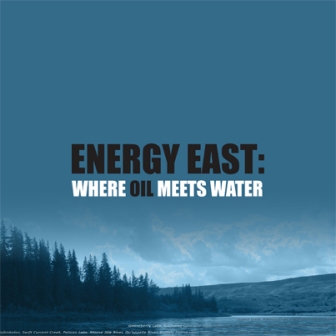Drinking water, beluga habitat, and fishing and swimming holes are all at risk if TransCanada’s proposed Energy East pipeline is approved, says a new report by the Council of Canadians.
Energy East: Where Oil Meets Water estimates that Energy East could spill more than one million litres of crude oil, including diluted bitumen from the tar sands, in just 10 minutes. By comparison, the 2013 spill in the Kalamazoo River in Michigan – the largest inland spill in the U.S. – spilled 3.8 million litres of diluted bitumen over the course of 17 hours.
“It simply is not worth the risk,” says Maude Barlow, national chairperson of the Council of Canadians. “The sheer volume of oil – one million barrels a day – that will go through Energy East is enormous. This means that when the pipeline spills, it will seriously endanger our water sources.”
The report released August 19,2014 by the Council of Canadians provides a snapshot of the characteristics and attributes of many waterways along Energy East’s 4,400-km path, which would span from Hardisty, Alberta to export ports in Cacouna, Quebec and Saint John, New Brunswick.
The report calls on municipalities and provincial governments along the pipeline path to commission independent scientific analyses to best evaluate the threat of a diluted bitumen spill in their areas.
“It is a mistake to rely on TransCanada and federal legislation to protect waterways from a spill or to clean up after a spill rapidly,” adds Andrea Harden-Donahue, energy and climate justice campaigner with the Council. “TransCanada refers to diluted bitumen sinking in water as a myth and the Harper government has gutted important environmental protections, leaving our waterways vulnerable.”
The Kalamazoo spill demonstrated that diluted bitumen spilled in water can sink, making conventional cleanup efforts largely ineffective. Four years later, with over $1 billion spent, submerged oil still remains in the river.
The Energy East pipeline would cross the drinking water sources of millions of Canadians. At points, the pipeline crosses waterways less than 20 km away from communities that draw their drinking water from that waterway. A spill could have devastating effects on waterways flowing through cities such as Winnipeg, Ottawa and Quebec City.
Numerous waterways are profiled in the report – from Battle River in Alberta to the Bay of Fundy in New Brunswick. The profiles draw on information provided in TransCanada’s Energy East pre-application project description to the National Energy Board, the existing pipeline slated for conversion, and local knowledge along the proposed route.
“We have a growing crisis of fresh water. We must collectively embrace our roles as water stewards,” concludes Barlow. “The Energy East pipeline would endanger our water. It’s too much for us to risk.”




Be the first to comment on "New report claims Energy East is an unacceptable risk to waterways"